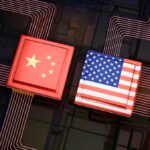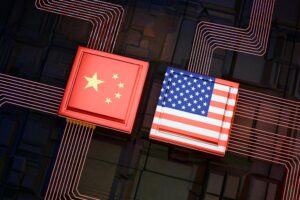
Veteran bond-fund manager Dan Fuss says investors should remain prepared for a potential escalation of tit-for-tat tariffs between U.S. and China even as they restart trade negotiations.
Fuss, an investor with 60 years of market experience, manages the $11 billion Loomis Sayles Bond Fund LSBRX, -0.07% In an interview, he told MarketWatch that the uncertainty around the U.S.-China trade fight and the potential for it to intensify further, meant investors should steer clear of areas of excessive leverage in financial markets.
“I don’t know how this is going to shape up. What seems to be happening is that what is known as the trade war or trade conflict is one aspect of how this is being worked out,” Fuss said.
He conceded that support by major central banks in the form of low-interest rate policies have helped prop up risk assets despite lingering questions around the global economy’s health, spurring intense demand among yield-starved foreign investors for U.S. corporate bonds.
For now, investors’ concerns around a trade war have waned as U.S. and China negotiators resumed talks after U.S. President Donald Trump and Chinese leader Xi Jinping met at the Group of 20 summit at the end of last month.
But Fuss says the state of trade negotiations could change swiftly, and that’s a danger investors should keep in mind. So far, the trade war’s negative impact has been limited to a few sectors such as soybean farming and manufacturing, while leading some corporations to shift their supply chains out of China to other Asian neighbors like Vietnam.
But another tariff hike to encompass a broader swathe of imports in China could shock a U.S. economy that has managed to mostly weather the steady increase in global growth fears emanating from trade tensions.
“If the walls really go up, tariffs get doubled and tripled, to the point that this becomes a wall to trade, now you’ve got a major adjustment and it affects a whole host of countries that have been growing at a clip,” said Fuss.
More pertinently for bond investors, high-yield corporate credit, leveraged loans and other pockets of leverage in U.S. financial markets could be exposed.
“This could really put them through the wringer, and that’s the fear,” said Fuss. “Any place where you’ve been investing on a seven-year basis and borrowing your money on a shorter-term basis comes under the label of uh-oh,” said Fuss. “So, depending on portfolio objectives, it’s best to have some highly liquid reserves right now.”
Leveraged loans have attracted increased attention from investors and others as a potential danger spot. Such loans are extended to companies that already have a substantial debt load, a poor credit history or both. Indeed, former Federal Deposit Insurance Corporation head Sheila Bair told MarketWatch last month that pain in that segment of the corporate-debt market could hit the real economy more quickly than the subprime crisis in 2008.
Around a quarter of Loomis Sayles Bond Fund’s portfolio is held in cash, as of data from June 30.
Fuss’s cautious positioning is true to his contrarian streak, with Wall Street investors advocating for larger holdings of corporate bonds to benefit from easy monetary policy and negative rates. Fuss is known for aggressively buying beaten-down bonds when investor sentiment soured, and selling when the market recovered.
He says credit spreads for high-yield bonds, issued by debt-laden corporations, remained too tight given that another flare-up in trade tensions could still come back into play. The yield spread between a basket of below investment-grade bonds and risk-free Treasurys TMUBMUSD10Y, -1.07% has traded around 4.03 percentage points on Tuesday, according to an index provided by ICE data services.
The iShares iBoxx USD High Yield Corporate Bond exchange-traded fund HYG, +0.15% , the largest such ETF tracking the performance of the U.S. sub-investment grade market, has returned nearly 10% on a total return basis in 2019. The fund has also attracted more than $4 billion of inflows year-to-date.
Other risk assets have thrived in 2019, too. The S&P 500 SPX, +0.46% and the Dow Jones Industrial Average DJIA, +0.90% have both hit all-time intraday highs this week.
“I’ve seen this story before many times, and in different guises. Markets can be non-discriminating, with people saying this risk or that risk doesn’t matter. As long as nothing happens that’s wonderful. But when something does happen, it’s felt in the market,” he said.
He clarified that in investment-grade bond issues that are more widely traded, the impact on credit spreads is likely to be muted. But in less liquid markets like high-yield debt, a sudden evaporation of market participants willing to buy bonds could lead to a steeper selloff. Thin liquidity conditions were also exacerbated by Wall Street trading desks retreating away from their market-making role after the 2010 Dodd-Frank Act.
“In the middle of the market, you have these levered private funds and hedge funds who don’t have an obligation to make the market. They only have an obligation to the make money for their owners,” said Fuss.
“In stocks you’ve got an auction market, you’ve got a regulation exchange. But in bonds, you don’t have that. You either own them or you don’t, there’s no buttonwood tree,” said Fuss, referring to an agreement reputedly signed under a buttonwood tree among New York stockbrokers to organize securities trading in 1792, which later preceded the formation of the New York Stock Exchange.
Still, he says once a more definitive resolution is reached on the U.S.-China trade spat, it could bring about plenty of opportunities.
“In that setting, we probably would be more fully invested,” he said. “My hope is that this gradually plays out so that we find a way for U.S and China to be part of a common economic sphere.”







